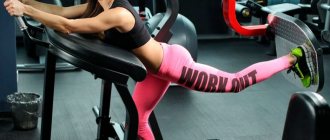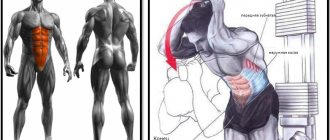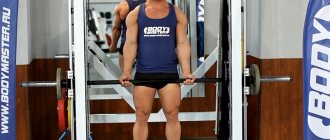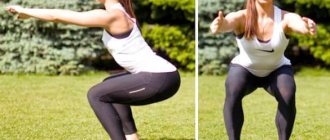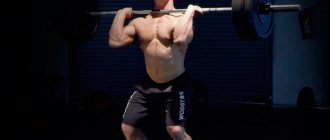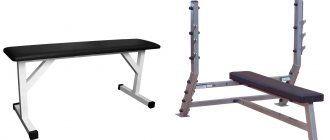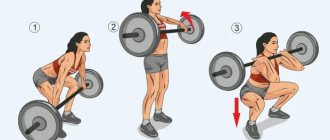People started asking how to learn how to bridge the bench press with the growing popularity of powerlifting. This is a sport in which the bench press is a competitive movement and the athlete's goal is to lift as much weight as possible in the lift. The bridge originally served to reduce the range of motion. The higher the chest, the shorter the path of the projectile, and the more you can squeeze. But over time, it has been proven that lifting fitness weights using bodybuilding technique on a flat back is not safe. Non-professionals have poor posture, hypertonicity of the trapezius and are often injured due to insufficient mobility in the shoulder joint. Learning how to bridge makes sense for everyone who lifts.
Why do you need a bridge in the bench press?
In addition to lifting significant weights, the bench press bridge is needed for:
- Engaging the back muscles. The lats help with movement, the diamonds stabilize the body. Among benchers, there are few people with an undeveloped “narrow” back;
- Corrections of office-type posture disorders. Are your shoulders pulled forward and your back hunched? A thoracic bridge will help get rid of this deficiency;
- Protects the spine while working with heavy weights. When an athlete is in the bridge, his muscles take a significant part of the load, and the spine is not injured from impacts during high-speed, high-repetition work.
Bridge - to be, in order to extract the benefits from this technique, you do not need a high deflection in the spirit of Japanese powerlifters, it is enough to learn to bring your shoulder blades together and push your chest up.
Work of muscles and joints
During a power press, many more muscle groups are used than during a classic bench press without a bridge, since the inclusion of a large number of muscle groups is, in fact, the task that the bridge performs. The load is placed on the legs, latissimus dorsi, triceps, anterior deltoids, biceps and the lower part of the pectoralis major muscle. In fact, the bridge press does not load the chest that much and only in a short segment of the range of motion. In the lower phase, while the elbow is behind the line of the body, the latissimus dorsi muscle takes on the load, since its function is to bring the arm to the body. Then the lower bundle of pectoral muscles is connected, and then the load smoothly goes to the anterior delta and triceps. The legs, abs and longus dorsi work as stabilizers throughout the entire range of motion, and the biceps are actively involved in the negative phase when the lifter lowers the barbell to the chest.
There are many joints involved during a power press; this is a basic multi-joint exercise. The load is distributed between the elbow and shoulder joints, thereby eliminating the possibility of injury. Of course, you can get injured anytime and anywhere, but by distributing the load between several joints, the likelihood of injury is significantly reduced. There is also one very important rule - the barbell must be handed to you, because when you independently remove it from the racks, the shoulder joint is in an unnatural position for it and the entire load falls on it and the anterior deltoid, so this should be avoided if possible. In addition, in your bench press training , you should generally use the help of a partner who can back you up and help you perform many different interesting exercises that help increase strength.
Bridge press technique
The easiest way to learn how to bridge the bench press is with an assistant:
- The athlete sits on the bench so that the bar is in front of his chest;
- The assistant makes sure that the arms are level on the bar and the shoulder blades are brought together;
- The athlete rests his palms on the bar, and sharply brings his shoulder blades towards the spine, his chest leans forward;
- In one movement, you step onto the bench, the shoulder blades touch its surface;
- The legs are comfortably placed on the floor so that the pelvis touches the bench; the feet can be placed completely on the floor or placed on the toes, but the latter is prohibited by the rules of some powerlifting federations;
- Next, they push off the bar with their hands, and push the chest up even more;
- When the athlete assumes the bridge position, the assistant delivers the barbell to straight, outstretched arms;
- While lowering the projectile, you need to think about how the top of your chest is trying to touch the projectile;
- When squeezing the barbell, start sharply and do not relax your back.
Athletes who are naturally flexible can sit on the edge of a bench and lower their shoulder blades into a flexed position. Those whose spine is stiff should perform lifting exercises and stretches. This is a gymnastic bridge, and lying on a bolster for MFR. The roller is placed under the shoulder blades, and they try to lower the pelvis and shoulders to the floor.
The bench press technique with a bridge also differs in the squeezing trajectory. The bar moves along an elliptical path, rather than straight up.
Too much bench press = risk of injury
Firstly, with a large deflection, a lot of pressure is created on the lower back. When the spine is severely arched, the intervertebral discs and nerves are at great risk of injury. Ask someone with a bad back to do a big back arch while doing a bench press, and the back pain will immediately make itself known.
Even taking into account the fact that the spine during such a deflection does not experience such a colossal load as during squats, but still, during heavy bench presses a lot of weight is used, and if the legs are also raised at the same time, the combination of these factors can lead to injury. (In addition, do not forget what cumulative trauma is – Zozhnik’s note).
Second, powerlifters are primarily concerned with their bench press, and most powerlifters regularly perform squats and deadlifts, which places significant stress on the spine. And since the muscles in the lower back do not recover as quickly, the bench press day in the program, which is intended as a “rest day” for the back and lower body, turns out to be another day of stress.
A strong arch in the back will also reduce stability in the legs. To bend your back well, your feet need to be behind your hips, but the further they go, the harder it is to maintain a stable position in your legs without lifting your buttocks from the bench.
Bench press with or without bridge: difference and technical features
With a large deflection, the triceps work predominantly, so athletes who bench press for aesthetics should perform a low deflection in the thoracic region. A “flat back” is allowed if:
- Light weight is used;
- The athlete is recovering from an injury;
- A very wide grip is used, more than a competition grip.
If these conditions are met, the pecs and triceps can be worked out well. But to develop the entire shoulder girdle and build strength, a deflection is needed. The athlete chooses a bench press with or without a bridge based on priorities and the development of flexibility and mobility.
Epilogue
The bridge bench press is an exercise technique that is mainly suitable for professional powerlifters; we can say that it is the prerogative of powerlifting professionals. This technique is not simple and it is aimed at maximum results. Just like the stiff-legged deadlift, this is a very specific exercise. And if you are able to master it and practice it in training, then you will definitely get quite a lot of benefits. And even if you cannot do such a bridge when pressing, which is shown in the video below, then do not despair. And even if you just don’t have the desire to do such a bridge as in the video, then in any case the general rules for performing the bench press are the same for everyone. But the depth of the bridge is a purely individual matter, but it should be present in every athlete performing a bench press.
How to develop a bridge in the bench press
Not all people are naturally flexible. How to develop a bridge in the bench press if, when bringing the shoulder blades together, the back still fully touches the bench, and the deflection is visible only in the lower back? It is necessary to do the following at the beginning of each workout:
- 1-2 minutes of standing in a gymnastic bridge. From a lying position on the floor, palms at ear level, elbows up, feet on the floor, lift your body up and come out into a full bridge. If it doesn’t work out, you can do it by lying on the fitball with your back and gradually increasing the deflection in the spine;
- 3-4 minutes lying on the floor, with a roller under the shoulder blades;
- first warm-up approach with an empty bar with a towel roll under the shoulder blades.
In addition to arching the spinal column, athletes must build strength in the back muscles. Weak lats and diamonds make it difficult to hold the body stable. The best exercises here are bent-over rows with a pause of 3-5 seconds at the point of peak contraction.
Additionally, the skill of rotating the shoulder joint is developed. During the warm-up, rubber bands are pulled towards the face, with the elbows moving behind the ears, then - circular rotations with the arms, including with small weights. The goal is to improve mobility so much that the reduced amplitude does not interfere with taking the starting position.
People with poor posture should pay increased attention to the starting position in the bench press. They need to learn to “push off” from the bar at the start so that their back remains tense throughout the exercise.
The bridge bench press is an exercise for the entire “top.” Starting with the chest, pressing with the triceps and anterior deltoids, and stabilizing with the back muscles is the “gold standard” of movement. Constant efforts in developing flexibility and strength will allow you to “paving” quite easily and high, and achieve good results in the bench press.
Execution technique
If you decide to work on strength, then you can try bench pressing using a bridge.
The chest press technique with a bridge is as follows:
- Starting position: lying on a horizontal bench, holding the barbell with a wide grip. Feet on the floor.
- The body is supported on the neck and legs. There is maximum deflection in the thoracic and lumbar regions. A stand on the shoulder blades and legs is performed, very similar to a wrestling bridge (hence the name). The pelvis only lightly touches the bench.
- Remove the barbell from the racks and smoothly lower it to your chest. Press the barbell upward, tensing the muscles of your legs, back and shoulder girdle.
I would like to note that this is a simplified version of the technique.
In powerlifting, it takes several months to develop a good bridge. And there are many other technical elements that need to be honed.
Therefore, if you are not going to do strength training, a simplified version will suffice.
Opinion of Dmitry Smirnov
At this point we say goodbye to Tim Henricks and present the opinion of former Men's Health fitness editor Dmitry Smirnov. He believes that there is nothing wrong with bending on the bench press: “Excessive bending in the lumbar region, especially under load, is really very dangerous. Only here the bridge is made by deflection in the lower part of the thoracic region, for which deflections (as well as mobility in general) are only beneficial. This is the only part of the spine that needs mobility, not stability. In principle, it is impossible to bend in the lumbar region; there is a margin of flexibility of only 14 degrees, if my memory serves me correctly.”
However, we are talking here about normal, not excessive deflection.
How to increase your bench press? Making a breakthrough
Greetings, my dear readers!
Have you ever wondered how to increase your bench press? If yes, then this article is for you. Today we will thoroughly analyze this basic exercise and get acquainted with specific tricks that improve “press” performance.
Well, the goals have been outlined and I can’t wait to get started, let’s begin.
Bench press: debriefing
I’ll say right away that you owe me this article.


